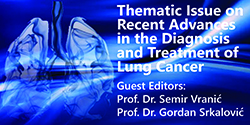Markedly elevated plasma D-dimer and the prevalence of acute pulmonary embolus
Keywords:
Pulmonary embolus, D-dimer, CTAbstract
Objective. To evaluate if increasingly elevated levels of plasma Ddimerare associated with higher prevalence of acute pulmonaryembolus (PE). Patients and Methods. A retrospective study wasconducted evaluating all PE protocol CT examinations performed inlow-to-intermediate risk emergency department and hospitalized patientsduring 2007. All PE protocol CT reports were reviewed for thepresence or absence of acute PE. Th e charts of all of these subjectswere then reviewed for quantitative plasma D-dimer values, measuredin mg/ml Fibrinogen Equivalent Units, drawn within one day prior tothe CT exam. Th e prevalence of acute PE at diff erent D-dimer thresholdresults was then evaluated using D-dimer groups as follows: < 1.0mg/ml, ≥ 1.0 but < 2.0 mg/ml, ≥ 2.0 but < 4.0 mg/ml, and ≥ 4.0 mg/ml. Results. 943 PE protocol CT exams were reviewed. 410 subjectshad D-dimer values drawn before their CT exams; 30 (7.3%) of thesewere positive for acute PE. As D-dimer values became increasingly elevated,the prevalence of acute PE increased accordingly. In particular,D-dimer elevation ≥4.0 mg/ml was almost 94% specifi c for acute PEby CT criteria. Conclusion. Increased elevation of plasma D-dimer isassociated with increased prevalence of acute PE in low-to-intermediaterisk patients.References
Remy-Jardin M, Remy J, Deschildre F, Artaud D, Beregi JP, Hossein-Foucher C, et al. Diagnosis of pulmonary embolism with spiral CT: comparison with pulmonary angiography and scintigraphy. Radiology. 1996;200:699-706.
Wells PS, Ginsberg JS, Anderson DR, Kearon C, Gent M, Turpie AG, et al. Use of a clinical model for safe management of patients with suspected pulmonary embolism. Ann Intern Med. 1998;129:997-1005.
Wells PS, Anderson DR, Rodger M, Ginsberg JS, Kearon C, Gent M, et al. Derivation of a simple clinical model to categorize patients probability of pulmonary embolism: increasing the models utility with the SimpliRED D-dimer. Th romb Haemost. 2000;83:416-20.
Stein PD, Hull RD, Patel KC, Olson RE, Ghali WA, Brant R, et al. D-dimer for the exclusion of acute venous thrombosis and pulmonary embolism: a systematic review. Ann Intern Med. 2004;140:589-602.
Gupta RT, Kakarla RK, Kirshenbaum KJ, Tapson VF. D-dimers and effi cacy of clinical risk estimation algorithms: sensitivity in evaluation of acute pulmonary embolism. AJR Am J Roentgenol. 2009;193:425-30.
Corwin MT, Donohoo JH, Partridge R, Egglin TK, Mayo-Smith WW. Do emergency physicians use serum D-dimer eff ectively to determine the need for CT when evaluating patients for pulmonary embolism? Review of 5,344 consecutive patients.
AJR Am J Roentgenol. 2009;192:1319-23.
Hirai LK, Takahashi JM, Yoon HC. A prospective evaluation of a quantitative D-dimer assay in the evaluation of acute pulmonary embolism. J Vasc Interv Radiol. 2007;18:970-4.
Gimber LH, Travis RI, Takahashi JM, Goodman TL, Yoon HC. Computed Tomography Angiography in Patients Evaluated for Acute Pulmonary Embolism with Low Serum D-dimer Levels: A
Prospective Study. Perm J. 2009;13:4-10.
Sanchez LD, McGillicuddy DC, Volz KA, Fan SL, Joyce N, Horowitz GL. Eff ect of two diff erent FDA-approved D-dimer assays on resource utilization in the emergency department. Acad Emerg Med. 2011;18(3):317-21.
Weiss CR, Haponik EF, Diette GB, Merriman B, Scatarige JC, Fishman EK. Pretest risk assessment in suspected acute pulmonary embolism. Acad Radiol. 2008;15:3-14.
Eng J, Krishnan JA, Segal JB, Bolger DT, Tamariz LJ, Streiff MB, et al. Accuracy of CT in the diagnosis of pulmonary embolism: a systemic literature review. AJR Am J Roentgenol. 2004;183:1819-27.






